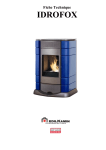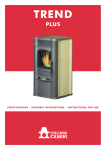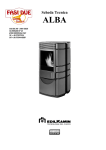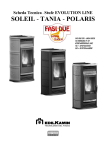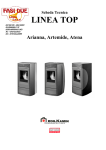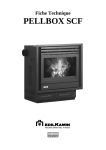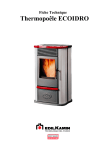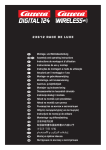Download EdilKamin POWER Specifications
Transcript
Specifications IDROFOX Dear Sir or Madam, thank you for choosing our Idrofox stove. Before using your stove, please read this booklet carefully: it explains how to exploit all its features to the full in complete safety. For any further information or needs, contact toll-free number (from Italy) +39 800-014142 Please remember that the 1st ignition MUST be carried out by a TAC (EdilKamin technical assistance centre authorized according to Italian law 46/90), which inspects the installation and fills in the guarantee. You can get a list of centres by visiting the contacts page on the EdilKamin web site www.edilkamin.com or by calling the toll free number shown above. The manufacturer cannot be held liable for any damage which may derive from using the stove after incorrect installation, incorrect maintenance or misuse. SAFETY INFORMATION THE STOVE MUST NEVER BE RUN WITHOUT WATER IN THE SYSTEM. “WATERLESS” IGNITION DAMAGES THE STOVE. The stove is designed to heat water through the automatic combustion of pellets in a firebox. The only risks which may derive from using the stove are linked with non-compliance with the installation instructions, direct contact with live electrical parts (inside) or with the fire or hot parts, and the introduction of foreign substances. If components fail, the stove is fitted with safety devices which turn it off. This must be allowed to happen without interference . For correct operation, the stove must be installed in compliance with the instructions herein, and the door must not be opened during operation: combustion is managed automatically so no manual operations are needed. Never put foreign substances in the firebox or hopper. Do not use flammable products to clean the smoke duct. Firebox and hopper components must only be cleaned WHEN COLD using a vacuum cleaner. The glass must be cleaned when COLD with a special product (e.g. GlassKamin) and cloth. Do not clean when hot. During stove operation, the outlet pipes and door reach high temperatures. Do not keep objects which are not able to withstand heat in the immediate vicinity of the stove. NEVER use liquid fuels to light the stove or rekindle the embers. Do not block ventilation openings in the room where the stove is installed or air inlets in the stove itself. Do not get the stove wet, and do not put wet hands near electrical parts. Do not fit reducers on the smoke outlet pipes. The stove must be installed in a suitable place as regards fire regulations, and provided with all the facilities (power supply and outlet) it requires for correct safe operation. CE STANDARDS and COMPLIANCE DECLARATION EdilKamin declares that the Idrofox stove complies with the following C.E. marking European Directives 73/23/EEC and later modification 93/68/EEC 89/336/EEC and later modifications 93/68/EEC, 92/31/EEC and 93/97 EEC In the case of installation in Italy, refer to Italian standard UNI 10683/98 or later modifications. For the domestic hot water and heating system, have the plumber issue a declaration according to Italian law No. 46/90. In all other countries, check the laws and national regulations on the subject. 2 INDEX Operating principle and reference dimensions Specifications, fuel and wiring diagram Exploded view with spare part codes Role of main components (TAC) Assembly and installation (TAC) Water connections (TAC) Possible system diagrams Covering assembly Interface: panel, remote control and pressure gauge Use Ignition Operating modes Switching off Clock adjustment Weekly programming Servicing: routine and annual (TAC) Advice in the event of problems Frequently asked questions Check list p. 4 p. 5 p. 6 p. 8 p. 8 p. 10 p. 10 p. 13 p. 14 p. 14 p. 15 p. 15 p. 15 p. 15 p. 16 p. 17 p. 19 p. 20 3 OPERATING PRINCIPLE The stove is pellet-fired with electronically controlled combustion. Pellets are small cylinders of pressed wood. The heat produced by combustion is mainly used to heat water, and only a small part radiates into the room where the stove is installed. The pellet hopper is at the top of the stove. The hopper is filled through the lid found at the back of the top. The fuel (pellets) is taken from the storage hopper (A) and delivered to the combustion chamber (D) by a screw feeder (B) driven by a gearmotor (C). The pellets are ignited by hot air produced by a heating element (E) which is drawn into the combustion chamber by a centrifugal fan (F). The combustion air is drawn from the room (where there must be an air intake not directly connect to the stove) by the centrifugal fan (F). The combustion smoke produced is drawn out of the firebox by the same centrifugal fan (F), and expelled from the nozzle (G) at the bottom rear of the stove. The ash falls into the pan (H) where it gathers for emptying. The water in the stove is heated and sent to the heating system by pump (I) built into the stove. The stove has a built-in closed expansion tank and overpressure relief valve. The amount of fuel, the smoke extraction/combustion air supply and pump operation are controlled by an electronic circuit board in order to achieve highly efficient fuel consumption. Operating modes (see p. 15 for further details) The water temperature required in the system (recommended average of 60°C) is set on the panel, and the stove modulates the power to maintain or reach this temperature. With small systems, the Eco function may be enabled (the stove turns off and on according to the water temperature). The external covering is available in the following colours and materials: grey or red steel; beige, Persian blue and wine-red ceramic 4 TECHNICAL AND HEATING SPECIFICATIONS Hopper capacity Overall efficiency Water efficiency Overall available power (min/max) Power available for water heating (min/max) Time between refuellings (min/max) Fuel consumption Heatable room dimensions only considering heating by hot water and calculating 35 kcal/m3 h Weight (steel/ceramic) Smoke duct diameter ELECTRICAL SPECIFICATIONS Power supply On/off switch: Average power consumption Average power consumption during ignition Remote control frequency Protection on mains power supply Electronic circuit board protection • • 35 Up to 90 Average of 79-80 4.5/18.5 3.5/15 9/35 1/4 80/ 360 kg % % kW kW hours kg/h m3 200/225 8 kg cm 230VAC +/- 10% 50 Hz yes 300 400 infrared 5 x 20 2A 250 VAC fuse 5 x 20 2A 250 VAC fuse W W The heatable room dimensions are calculated assuming the use of pellets of the type described in the note, and home insulation which complies with Italian law No.10/91. A LOT DEPENDS ON THE EFFICIENCY OF THE HEAT EMITTING UNITS (RADIATORS). Bear in mind that more than 15 kW is NOT needed. NOTES on fuel. The Idrofox pellet stove is designed and programmed to burn pellets. Pellets are small 6 mm diameter (approx.) fuel cylinders made from sawdust and ground waste wood pressed at high pressure without adhesives or other foreign material. They are sold in 15 kg bags. In order NOT to jeopardize stove operation, do NOT burn other substances. The use of other materials (including wood), which can be detected by laboratory analyses, invalidates the guarantee. EdilKamin has designed, tested and programmed its stoves to perform best with pellets with the following characteristics: diameter: 6 - 7 millimetres; maximum length: 40 mm; maximum moisture content: 8 %; heat output: 4300 kcal/kg (at least) Use of unsuitable pellets may lead to: a decrease in efficiency; operating anomalies; stoppages due to clogging, dirty glass, unburnt fuel, etc. Remember to comply with fire safety distances See p. 9 WIRING DIAGRAM CONTROL PANEL MAINTENANCE RS232 AUX SMOKE RPM IN T J WATER OUTLET TEMPERATURE DETECTOR LITHIUM BATTERY 2A FUSE 230 V AC 50 Hz +/- 10% MAINS SMOKE EXTRACTION MOTOR IGNITION HEATING ELEMENT 120°C TM 2A FUSE 90°C TM ∆P 40 Pa SCREW FEEDER MOTOR WATER CIRCULATION PUMP 2A FUSE AUX PORT The TAC may install a device for remote on/off operation on the electronic circuit board (the AUX port). 5 6 Item Description Code Num of pcs. Ite m Description Code Num of pcs. Ite m Description 270870 Num of pcs. 1 Left covering fastening shoulder Electronic circuit board Power supply cable Electric cable kit Remote control 3/8" air bleed valve 271480 230210 271490 232730 269550 1 1 1 1 1 269560 269570 269670 269520 269510 269540 1 1 1 1 1 1 269500 1 94 Automatic air bleed valve 1/2" M/F safety valve 20 mm diam. 3/4" outlet pipe 3 bar safety valve 25/50 circulation pump 100°C water safety thermostat mod. 8-7508 3/4" closed expansion tank Anti-vibration rubber bung 234420 4 95 3/4" pipe nipples 269640 4 269710 269650 269700 269660 269580 1 2 1 1 1 272160 269690 269680 1 1 1 235210 261980 270620 270200 197560 272540 238030 199040 1 5 1 1 1 1 1 1 271500 6630 196500 261320 272310 269600 269570 1 1 1 1 1 1 1 119 120 121 Outlet pipe 2 1/2" M 1/2" F bend Outlet pipe 1 Inlet pipe Sleeving for capillary instruments 1/2" M 3/8F connector Connecting pipe Expansion tank connecting bend Power socket with switch 3/4" pipe fastening nut Lower rear panel Upper rear panel Door handle Flat cable Pressure switch Silicone tube for pressure switch Water temperature detector Reversible EK glove Scraper Desiccant crystals Pipe cleaner with brush Small check valve Male/female ISO228 safety valve 3/4" gasket 1/2" gasket 1" gasket 262010 262020 269620 7 1 2 122 1 1/2" silicone rubber gasket 262030 2 1 Anti-vibration feet 40 x 25 x 8/70 shr 274040 4 38 Upper loader cover 247480 1 81 2 3 4 5 6 Metal frame Ash pan Ash guard Upper cast iron grille Duct cleaning scraper 264490 270310 271570 270860 272450 1 1 1 1 1 39 40 41 42 43 247330 255360 270350 270690 249010 1 1 1 1 2 82 83 84 85 86 7 8 9 10 11 12 M5 nut Front inspection panel Scraper knob Front cleaning scraper Rear scraper Duct cleaning cover 8880 270930 252330 272390 272523 272530 4 1 2 1 1 1 44 45 46 47 48 49 Screw feeder half cover Screw feeder safety thermostat Loader body Pellet outlet gasket Teflon coated bush for screw feeder Screw feeder shaft Ceramic paper loader gasket Lower shaft locking flange Gearmotor locking bush MK2 gearmotor, rpm Smoke probe thermocouple 249343 247380 247320 232580 237900 255370 1 1 1 1 1 1 87 88 89 90 91 92 13 10 x 2 black adhesive gasket 425810 L=0.7 m 50 Internal pellet chute cover 271780 1 93 14 Stainless steel TCL screws/ M5 x 16 hexagonal slot Lower top 206350 2 51 Smoke extractor 215130 1 15 270660 1 52 201010 1 16 17 18 19 20 Spacers Intermediate top Cast iron upper inspection cover Silicone rubber bung Upper top 196370 270340 270770 216510 270330 4 1 1 2 1 53 54 55 56 57 255090 201020 270280 270300 363820 1 1 1 1 1 96 97 98 99 100 21 22 23 Pellet cover hinge Pellet cover Display-control switch 270680 270320 232720 2 1 1 58 59 60 Smoke motor ceramic paper gasket Cast iron smoke outlet spiral Smoke duct gasket Smoke duct Smoke duct cover Internal combustion chamber divider Combustion chamber Ash grate Combustion chamber door 270900 270980 270290 1 1 1 101 102 103 24 25 26 27 28 29 30 30 Pressure gauge Lower door fastening bracket Left upright Right upright Left base Right base Grey steel panel Red steel panel 269590 270820 270910 270920 190420 190410 197600 197590 1 1 1 1 1 1 2 2 61 62 63 64 65 66 67 68 Ignition heating element Ignition heating element bush Cast iron door 13 mm diam. door gasket Upper M10 adjustment pin M5 x 20 nut Handle fastener TSP screw/5 x 20 hexagonal slot 248510 247350 269040 224660 270560 44830 194440 246130 1 1 1 L=1.9 m 1 1 1 2 104 105 106 107 108 109 110 111 31 31 31 32 32 32 33 13.5 h Persian blue ceramic side 13.5 h beige ceramic side 13.5 h wine-red ceramic side 40 h Persian blue ceramic side 40 h beige ceramic side 40 h wine-red ceramic side Ceramic covering fastening bracket 201410 213230 213210 201420 213240 213220 166490 8 8 8 2 2 2 8 69 70 71 72 73 74 75 D.8 corrugated washer Left glass holder Glass Right glass holder Upper glass holder Air conveyor Lower M10 adjustment pin 162470 270710 193630 270720 271770 270730 270570 2 1 1 1 1 1 1 112 113 114 115 116 117 118 33 34 35 Metal covering fastening bracket Pellet protection grille Rear pellet hopper wall 166490 270790 270580 4 1 1 76 77 78 269060 270810 224660 1 1 L=1.020 m 36 37 Pellet hopper 6 mm diam. plait gasket 270830 254040 1 L=0.78 79 80 Lower cast iron front panel Lower front panel handle 13 mm diam. lower front panel gasket 8 x 2 black adhesive gasket Right covering fastening shoulder 173050 270880 L=1.3 m 1 Code 7 ROLE OF SAFETY DEVICES AND DETECTORS fitted to the stove • Smoke thermocouple: on the smoke outlet. It reads the smoke temperature. It regulates the ignition stage and shuts the stove down if the temperature is too high or too low (flame stop or excessive smoke temperature stop respectively). • Pressure switch: It measures the pressure near the smoke extractor and stops pellet loading by cutting off the electricity supply to the gearmotor if the pressure is insufficient (due to INsufficient smoke outlet or the stove door being open). • Screw feeder safety thermostat: found near the pellet hopper. It starts a shutdown if the temperature detected is too high. • Water temperature detector: It reads the water temperature in the stove and sends the circuit board information for pump management and stove power modulation. If the temperature is too high, it starts a shutdown. • Water temperature safety thermostat: It reads the water temperature in the stove. If the temperature is too high, it starts a shutdown by cutting off the electricity power supply to the gearmotor. If it has tripped, it may be reset by pressing the reset button behind the stove. • Overpressure valve: when the rated pressure is reached, it drains water from the system thus creating the need for a top up. • Pressure gauge: found under the pellet loading lid. It shows the water pressure in the stove IF THE STOVE SHUTS DOWN, THE REASON APPEARS ON THE DISPLAY AND IS STORED IN THE MEMORY. ROLE OF STOVE COMPONENTS • • • • • • • • Ignition heating element: It ignites the pellets. It remains on during the ignition stage until the smoke temperature increases by 15°C. Smoke extractor: It “pushes” out the smoke and draws in fuel air through the vacuum it creates. Gearmotor: It moves the screw feeder and loads pellets from the hopper into the combustion chamber. Pump: It “pushes” the water out into the system. Closed expansion tank: it “absorbs” the changes in water volume in the stove. o !A separate expansion tank should be provided for the system! Automatic bleed valve: found in the upper part. It may be used to “bleed off” any air Manual bleed valve: found in the upper part. It may be used to “bleed off” any air Drain cock: found inside the stove at the bottom; it should be used to empty the boiler-stove of water. ASSEMBLY AND INSTALLATION (TAC - technical assistance centre) Refer to the local regulations in the country of use for anything not expressly shown. In Italy, refer to Italian standard 10683/1998 or later modifications, and Italian law No. 46/90 along with any regional or local health authority regulations. If the stove is to be installed in a block of flats, consult the block administration before installing. COMPATIBILITY CHECK WITH OTHER DEVICES According to Italian standard UNI 10683/98, the stove must NOT be installed in the same room as extractor fans, type B gas equipment or devices which lower the pressure in the room. ELECTRICAL CONNECTION CHECK (THE PLUG MUST BE IN AN ACCESSIBLE PLACE) The stove is fitted with an electrical power cord for connection to a 230 V 50 Hz socket, preferably protected with a thermal-magnetic circuit breaker. Voltage variations of greater than 10% may impair stove operation (if not already installed, fit a suitable residual current circuit breaker). The electrical system must comply with the law; in particular make sure the earth circuit is in working order. The power supply line must have a suitable cross-section for the equipment rating. LOCATION For correct operation the stove must be level. Check the load-bearing capacity of the floor. 8 FIRE SAFETY DISTANCES The stove must be installed in compliance with the following safety conditions: - minimum safety distance at the sides and back from medium-level flammable materials: 40 cm - easily flammable materials must not be located less than 80 cm from the front of the stove - if the stove is installed on a flammable floor, a sheet of heat insulating material must be placed between the stove and the floor, which protrudes by at least 20 cm at the sides and 40 cm at the front. Objects made of flammable materials must not be placed on the stove or at less than the safety distance from it. If the smoke outlet pipe is connected to walls made of wood or other flammable materials, it must be insulated with ceramic fibre or other materials with similar characteristics. AIR INTAKE The room where the stove is located must have an air intake with cross section of at least 80 cm2 to ensure replenishment of the air consumed by combustion. SMOKE OUTLET The stove must have its own smoke outlet (it must not discharge into common flues or other devices). The smoke leaves the stove through the 8 cm diameter pipe at the back. A T-section with condensation trap and bleeder must be fitted at the beginning of the vertical section. The stove smoke outlet must be connected with the outside using black painted or steel pipes (resistant to 450°C), without obstructions. The pipe seals must be air-tight. To seal and insulate (if necessary) the pipes, material that withstands up to 300°C must be used (silicone or high temperature mastic). The horizontal sections may be up to 2 m long. Up to three 90° bends may be included. If the smoke outlet does not end in a flue, a suitably fixed vertical section (at least 1.5 m long unless clearly unadvisable for safety reasons) with wind guard at the end is essential. The vertical duct section may be indoor or outdoor. If the smoke duct is outdoor, it must be insulated. If the smoke duct ends in a flue, the flue must be authorized for solid fuel. If it is more than 150 mm in diameter, it must be renewed by inserting an internal pipe and sealing the smoke outlet from the brickwork. All sections of the smoke duct must be inspectable. If it is fixed, cleaning inspection openings must be provided. The recommended installations are those shown in the following figures. Smoke 1.5 m minimum h Air intake from outside to room (minimum internal section: 80 cm2) Brick-built flue Air intake from outside to room (minimum internal section: 80 cm2) 9 WATER CONNECTIONS (by authorized TAC) THE STOVE MUST NEVER BE RUN WITHOUT WATER IN THE SYSTEM. “WATERLESS” IGNITION DAMAGES THE STOVE. Plumbing must be carried out by qualified staff authorized to issue declarations of conformity in compliance with Italian law No. 46/90. Water treatment Add antifreeze, scale inhibitors and corrosion inhibitors. If the top-up water has a hardness greater than 35°F, use a water softener to reduce it. Refer to Italian standard UNI 8065-1989 (Water treatment in domestic heating systems). Practical NOTE When connecting the outlet, inlet and drain piping (see page 4), fit suitable means to make moving the stove easy in the future (for example, flexible piping for the first 0.5 m) A few possible indicative system designs are shown below. Idrofox system as unique heat source. This layout is purely indicative. Have a plumber design and install the system IDROFOX system as unique heat source. This layout is purely indicative. Have a plumber design and install the system. AF: AL: C: GR: MI: P: RA: RI: S: ST: TS: V: VA: Vec: VSP: VST: Cold water Water supply Filling/Topping up Filling unit Outlet to system Pump (circulator) Radiators Inlet from system Drain Temperature detector Boiler-Stove Ball valve Automatic bleed valve Closed expansion tank Safety pressure valve High temperature drainage valve Internal stove components 10 IDROFOX system for heating, combined with a water heater for producing domestic hot water. Idrofox and the water heater must operate as alternatives. A suitable system must be provided for turning the water heater on and off (such as a contact thermostat) This layout is purely indicative. Have a plumber design and install the system. AF: AL: C: CA: EV3 GR: MI: P: RA: RI: S: ST: TS: TC: V: VA: Vec: VR: VSP: Cold water Water supply Filling/Topping up Wall mounted water heater Three-way solenoid valve NA: Normally open NC: Normally closed Filling unit Outlet to system Pump (circulator) Radiators Inlet from system Drain Temperature detector Boiler-Stove Contact thermostat Ball valve Automatic bleed valve Closed expansion tank Check valve Safety pressure valve Internal stove components IDROFOX system combined with a water heater for producing domestic hot water with assembled KIT 4 This layout is purely indicative. Have a plumber design and install the system. ACS: AF: AL: C: CA: EV F: GR: MI: P: PS: RA: RE: RI: S: AC: ST: TC: TS: V: Vec: VR: VSP: VST: Domestic hot water Cold water Water supply Filling/Topping up Wall mounted water heater Three-way solenoid valve NA: Normally open NC: Normally closed Flow switch Filling unit Outlet to system Pump (circulator) Detector housing Radiators Electronic regulator Inlet from system Drain Plate heat exchanger Temperature detector Contact thermostat Boiler-Stove Ball valve Closed expansion tank Check valve Safety pressure valve High temperature drainage Internal stove components 11 IDROFOX system as unique heat source, with water heater for domestic hot water production It is essential to fit a suitable electronic regulator to manage the water heater. This layout is purely indicative. Have a plumber design and install the system. ACS: AL: B: C: EV2 EV3 GR: M MI: P: RA: RE: RI: S: SI: TS: V: VA: Vec: VSP: Domestic hot water Water supply Water heater Filling/Topping up Two-way solenoid valve Three-way solenoid valve NA: Normally open NC: Normally closed Filling unit Mixer valve Outlet to system Pump (circulator) Radiators Electronic regulator Inlet from system Drain Immersion probe Pellet-fired boiler-stove Ball valve Automatic bleed valve Closed expansion tank Safety pressure valve Internal stove components ACCESSORIES The two diagrams shown above only include components available on the EdilKamin price list • • • Kit 4 (cod. 264290) pre-assembled kit for boiler-stoves for producing domestic hot water (20 plate heat exchanger, power-driven three-way valve, high temperature drainage valve, flow switch and electronic regulator.) Optional extra for wall installation (cod. 262140) Water heater with one (cod. 264750) or two (cod. 264760) fixed heat exchangers for producing and storing domestic hot water. 150 l capacity. Spare parts are also available (heat exchanger, valves, etc.) 1st IGNITION (TAC) Make sure that the plumbing has been correctly installed and fitted with a sufficiently sized expansion tank to assure safety. The expansion tank built into the boiler-stove does not provide suitable protection against the thermal expansion of the water in the whole system. Turn the stove power supply on and carry out cold tests (TAC). Fill the system through the filling valve (do not exceed 1 bar in pressure) While filling, “bleed” the pump and the bleed valve. Once filled and once the smoke outlet connection has been checked, fill the screw feeder by pressing the + and – keys together. After about five minutes, the first pellets fall into the combustion chamber. Press the 0/1 key. The stove is ready for turning on. 12 COVERING ASSEMBLY The spare part codes are shown on the exploded view on p. 7 CERAMIC IDROFOX Covering parts list: ceramic part fastening bracket guides right cast iron base (29) left cast iron base (28) 8 fastening brackets for side ceramic parts (33) 8 13.5 h small side ceramic parts (31) 2 40 h large side ceramic parts (32) Covering assembly After positioning the frame as shown in the previous section, proceed as follows: Centre the base parts against the frame. Put the first of the small pieces from the bottom in place Screw the first fastening bracket to the metal guides already fixed to the stove, and slip the lower pin into the small ceramic side part. Put the second small ceramic component in place by slipping it into the bracket. Screw a fastening bracket to the metal guide and slip its lower pin into the small ceramic part. Proceed in a similar way up to the top of the stove. STEEL IDROFOX Covering parts list: left cast iron base (28) right cast iron base (29) 2 steel side parts (30) [interchangeable right and left] 4 fastening brackets for steel parts (33) Covering assembly After positioning the frame as shown in the previous section, proceed as follows: Centre the base parts against the frame. Slip the side parts onto the frame. 13 cTHE INTERFACE Panel with display and 4 keys : 0/1: to turn on and off Menu: to access the menu +/-: to increase/decrease the various settings Remote control To use the remote control, point it towards the stove. A beep confirms command reception, which is also confirmed by the command taking place. 4 keys (0/1, menu, + and -) to turn on and off and increase/decrease the temperature. The most frequent cause of remote control malfunction is flat batteries. Replace and dispose of old batteries. Pressure gauge It is mainly useful to technicians. It is found under the pellet loading lid and shows the water pressure in the system. USE Before ignition. 1st Ignition: contact your local TAC (technical assistance centre). The first few times the stove is ignited there may be a slight smell of paint, which disappears rapidly. Before ignition, check: • that the stove has been installed and water connected correctly (make sure the system has been bled) • the electrical power supply (turn the switch on the electrical socket to 1) • the door is closed. • the combustion chamber is clean. • the display is on standby (date and time). SCREW FEEDER LOADING. If the pellet hopper empties, press the + and - keys together to fill the screw feeder. This must be done before igniting the stove again if it has shut down due to running out of pellets. It is normal for a few pellets to be left in the hopper, which the screw feeder is not able to pick up. IGNITION Automatic ignition Hold the 0/1 key down for two seconds with the stove on standby to start the ignition procedure. The word Start appears on the display for a few minutes (ignition does not take a preset time: it is automatically shortened if the electronics detect that certain tests are passed). The flame appears after about five minutes. It is normal for a little smoke to be seen in the combustion chamber before the flame appears. Start remains on the display until the flame is stable. Manual ignition At temperatures of less than 3°C (too low for the heating element to glow) or if the heating element is temporarily out of order, a firelighter may be used for ignition. Put a piece of well lit firelighter into the combustion chamber, close the door and press the 0/1 button. 14 OPERATING MODES Set the water temperature required in the system (60°C recommended) on the panel. The stove modulates the power to maintain or reach this temperature. The Eco function may be enabled for small systems (see TAC adjustments). In this case, the stove turns off when the water reaches the set temperature and turns back on again to modulate the power. Switching off Hold the 0/1 key down for two seconds while the stove is operating. The shutdown starts and the word Off appears on the display (for 10 minutes). During shutdown: • Pellet loading ceases. • Ventilation turns up to maximum • The water circulates. Never unplug the stove while it is shutting down Clock adjustment Hold the menu key down for two seconds to access the menu. The on-board clock operating parameters may be set from this menu. Weekly time programmer Press the menu key for two seconds to access the time setting function and press + to access weekly time programming: the message "timer on/off" appears on the display. The stove may be programmed to come on and switch off automatically up to three times a day on each day of the week. Confirm with the "menu" key while the display shows "timer On/off". One of the following messages appears: NO PROGRAM (not programmed) DAILY PROGRAM (programmed to do the same thing every day) WEEKLY PROGRAM (programmed differently for each day) You can go from one to another using the + and - keys. Confirm the "DAILY PROGRAM" option with the menu key to choose the number of programs (on/off) per day. If you confirm "DAILY PROGRAM", the program(s) set will be the same every day of the week. After confirming "WEEKLY PROGRAM", choose the day the program applies to: 1 Mon, 2 Tue, 3 Wed, 4 Thu, 5 Fri, 6 Sat and 7 Sun Once the day has been selected using the + and - keys and confirmed with the menu key, continue in the same way as for the "DAILY PROGRAM". Choose the number of programs and the times for each day of the week. If you make a mistake while programming, you can exit by pressing the 0/1 key: the display shows "Saved". Change pellet load Press the menu key for two seconds and scroll through the items using the +/- keys until "adj.pellet" appears on the display. Confirm this item by pressing the menu key. The pellet load setting appears. This function may be useful if the type of pellet the stove has been calibrated for is changed, thus making load adjustment necessary. If adjusting this setting is not sufficient, contact the TAC (technical assistance centre) for a new operating setup. COLD TEST (I/O TEST) This menu is only accessible when the stove is on standby. It is used to check the components. It may only be accessed by authorized TAC (Technical Assistance Centre) staff: a password is required. Parameter adjustment Press the menu key for two seconds and scroll through the items using the +/ - keys until "setup" appears on the display. The main stove parameters may be adjusted on this menu. It may only be accessed by authorized TAC (Technical Assistance Centre) staff: a password is required. 15 SERVICING After 2500 kg of pellets are consumed, the display shows the word "Services???”. The stove does NOT stop, but announces the need for servicing by a TAC. Regular maintenance is essential for good stove operation. IMPORTANT: USE THE CLEANING RODS Before carrying out any maintenance, disconnect the device from the mains power supply DAILY CLEANING Clean with a vacuum cleaner. The whole process only takes a few minutes a day. Use the VACUUM CLEANER when the stove is cold. Remove front panel and operate front and rear scrapers (parts 10 and 11 on the exploded view on p. 6-7) Open cover. Use scraper provided (part 6 in the exploded view on p. 6-7) to clean heat exchange tubes in the firebox. Vacuum clean hearth and vacuum clean the space around the combustion chamber where the ash falls. Remove combustion chamber or clean it with a scraper, and unblock any blocked holes on all sides. Remove and empty ash pan, and vacuum clean the underlying compartment. Vacuum clean combustion chamber compartment, clean touching edges and replace combustion chamber. If necessary clean glass (when cold). NEVER VACUUM CLEAN HOT ASH IT IS ESSENTIAL TO CLEAN THE HEAT EXCHANGE PIPES 16 EVERY SEASON (by the TAC - technical assistance centre) The authorized TAC will give you a maintenance booklet after the first Idrofox stove ignition General internal and external cleaning. Carefully clean heat exchange pipes. Carefully clean and descale combustion chamber and corresponding compartment. Clean motors and mechanically inspect the play and fastenings. Clean smoke duct (replace gasket on the smoke outlet pipe) and smoke extractor fan compartment. Clean pressure switch and replace silicone tube. Check expansion tank. Check and clean circulator pump. Check probes. Replace clock battery on the electronic circuit board. Clean, inspect and descale ignition heating element compartment and change heating element if necessary. Clean/check display-control panel. Visually inspect electric cables, connections and power cord. Clean pellet hopper and check screw feeder-gearmotor assembly play. Change door seal. Test screw feeder loading, ignition, operation for ten minutes, and shutdown. If the stove is used frequently, it is advisable to clean the smoke duct every 3 months. ADVICE IN THE EVENT OF PROBLEMS PROBLEM CAUSE display-control panel off no mains voltage remote control not working Water not hot excessive distance from stove remote control batteries flat too much soot in heat exchanger SOLUTIONS check power cord connection check fuse (on power cord) check flat cable connection to display-control panel move nearer to stove check and change if necessary clean heat exchanger from inside the firebox The chimney pots and smoke ducts connected to solid fuel devices must be brushed once a year (check whether there are regulations on the subject in the country of installation). If inspection and regular cleaning are not carried out, the probability of a chimney pot fire increases. In the event of a chimney pot fire, proceed as follows: do not use water to extinguish; empty pellet hopper; and contact specialist staff after the accident before starting up again. POSSIBLE CAUSES OF SHUTDOWN If the stove shuts down, the reason is shown on the display. 1) Broken PTC H20: shutdown due to water temperature detector failure or disconnection 2) No expulsion: shutdown due to a fault detected by the smoke exhaust motor sensor 3) No fire: shutdown due to a drop in smoke temperature 4) No start: shutdown due to incorrect smoke temperature during ignition 5) Power failure: shutdown due to power failure 6) Termoc broken: shutdown due to thermocouple failure or disconnection 7) Over temp: shutdown when the maximum smoke temperature set is exceeded. 8) H2O temp alarm: shutdown due to a water temperature of above 90°C The message is displayed until the 0/1 key on the panel is pressed. Do not restart the stove until the problem has been looked into and the cause removed. To start the stove up again after a shutdown, let the shutdown procedure end (10 minutes marked by a beep) then press the 0/1 key. Never unplug the stove while it is shutting down due to problems. It is important to report what the panel says to the TAC (technical assistance centre). 17 ADVICE IN THE EVENT OF PROBLEMS 1) Broken PTC H20 (this trips if the water temperature detector fails or is disconnected) Check connection between the detector and the circuit board. Check operation with cold tests. 2) No Expulsion (this trips if the smoke extraction speed sensor detects a fault) - Check smoke extractor operation (speed sensor connection). - Make sure the smoke duct is clean. 3) No fire (this trips if the thermocouple detects a smoke temperature lower than the value set, which it interprets as the absence of flames) There may be no flames because - there are no pellets; - too many pellets have smothered the flames; - the maximum thermostat/pressure switch/water safety thermostat has tripped to “stop” the gearmotor. 4) No start (this trips if no flames appear and the start-up temperature is not reached within a maximum of 15 minutes). There are two distinct cases the flame does NOT appear Flames appear, but after the word "Start", the message "Start Failed" appears Check: Check: - combustion chamber position and cleanliness; - if the thermocouple is working; - if the heating element is working; - start-up temperature setting in the parameters. - room temperature (if lower than 3°C use a firelighter) and damp. Try to light with a firelighter. 5) Power failure Check the electrical connection and for voltage drops 6) Termoc broken (this trips if the thermocouple fails or is disconnected) Check connection between the thermocouple and the circuit board. Check operation with cold tests. 7) Over temp (shutdown due to excessive smoke temperature) Excessive smoke temperature may be caused by: the type of pellet, smoke extraction fault, blocked duct, incorrect installation, or gearmotor "drift". 8) H2O Alarm (this trips if the water temperature detector reads a temperature of above 90°C) Excessive temperature may be caused by: undersized system: have the TAC enable the ECO function; clogging: clean exchange pipes, the combustion chamber and smoke outlet. Pellets can NOT fall into the combustion chamber for the following reasons: • There are no pellets: fill the hopper. • The screw feeder is empty: fill the screw feeder by pressing the + and - keys together. • Some pellets have jammed in the hopper: empty the pellet hopper with a vacuum cleaner. • The gearmotor has broken down. • The pressure switch has “disconnected” the electrical power supply from the gearmotor: check installation, smoke duct cleanliness, and pressure in the extractor. Check using a volt-ohm-milliammeter or fit a temporary jumper. • The screw feeder safety thermostat has “disconnected” the electricity power supply from the gearmotor: make sure there is no overheating. Check using a volt-ohm-milliammeter or fit a temporary jumper. • The excess water temperature safety thermostat has “disconnected” the electricity power supply from the gearmotor: check if there is water in the stove. Press the button behind the stove to reset. It is essential to contact a TAC before starting up again. 18 FAQ The answers shown here summarize the information found in these specifications. 1) What fittings do I need in order to install Idrofox? Smoke outlet of at least 80 mm in diameter (the outlet must ONLY receive smoke from Idrofox). Air intake in the room of at least 80 cm2. ¾” G manifold outlet and inlet. ¾” G outlet to drain for overpressure valve. Coupling for ¾” G filling line. Connection to an electrical system compliant with standards, with a 230V +/- 10% 50 Hz thermal-magnetic circuit breaker. Refer to page 4 for dimensions. Read the safe installation information on page 8. THE FLUE MUST ONLY RECEIVE SMOKE FROM IDROFOX 2) Can I use the stove without connecting it to the domestic water system? NO. Use without water damages the stove. 3) Does the Idrofox stove give out hot air? NO. All the heat goes where it is needed: to the water. Part of the heat produced is radiated into the room. It is advisable to fit the room with radiators. 4) Can I connect the stove inlet and outlet directly to a radiator? NO, like all other water heaters, they must be connected to a manifold from which the water is distributed to the heat emitting units (radiators). 5) Does the Idrofox stove also provide domestic hot water? It is possible to produce it using our kit No. 4 (consisting of a heat exchanger, three-way valve, high temperature valve and regulator) or produce it and store it with one of our water heaters (see plumbing diagrams). This use reduces the power available to the radiators. 6) Can the Idrofox smoke outlet pass directly through the wall? NO, there must be a vertical section of at least 1,5 metres. Otherwise, a small amount of smoke may be perceived in the room in the event of power failure or wind. THE FLUE MUST ONLY RECEIVE SMOKE FROM IDROFOX 7) Does there have to be an air intake in the room? Yes, to replenish the air in the room. There is no direct connection between the air intake and the stove: the smoke extractor draws air from the room and supplies it to the combustion chamber. 8) What do I have to set on the stove display? The water temperature required: the stove modulates the power on the basis of this setting to attain or maintain it. For small systems, the stove may be programmed to turn on and off according to the water temperature reached. 9) How often do I have to clean the combustion chamber? Ideally before each stove ignition, while cold before turning it on. Clean the chamber AFTER CLEANING THE PIPES WITH THE BRUSHES and operating the cleaning scrapers (see p. 16) 10) Should I vacuum clean the pellet hopper? Yes, at least once a month or if the stove has not been used for a long time. 11) Can I burn other things apart from pellets? NO. The stove is designed to burn pellets. Other materials may damage it. 12) Can I turn the stove on with a mobile phone text message? Yes, if the TAC or an electrician has installed a suitable dialler (contact an electrical shop) at the electronic circuit board AUX PORT (see p. 5). 19 CHECK LIST Read the entire specifications before using this list Installation and setup • • • Installation carried out by an authorized TAC which has issued the guarantee and maintenance booklet; o Room ventilation; o The smoke duct/flue only receives smoke from the stove; o The smoke duct has: no more than 3 bends; a horizontal section of no more than 2 metres; a vertical section of at least 1.5 metres; o The outlet pipes are made of a suitable material (stainless steel is recommended); o Where pipes cross any flammable materials (e.g. wood) all precautions have been taken to avoid fire; The plumbing has been declared as compliant with Italian law No. 46/90 by an authorized technician; The heatable room dimensions have been suitably calculated considering the heating efficiency of the heat emitting units (radiators). Use • • • • • The pellets used are good quality and not damp; The combustion chamber and ash pan are clean and have been placed correctly; The cleaning rods are operated every day; The heat exchange pipes are clean (use pipe cleaner); The pressure (read on the gauge) is about 1 bar. REMEMBER TO VACUUM CLEAN THE COMBUSTION CHAMBER BEFORE EACH IGNITION If ignition fails, do NOT repeat ignition before emptying the combustion chamber Via Mascagni, 7 - 20020 LAINATE (MI) - Italy Tel. +39 02937621 – Fax +39 0293762400 www.edilkamin.com - [email protected] EdilKamin S.p.A. reserves the right to modify parts of the following manual without prior notice: cod. 272340 …-05.06/A 20




















